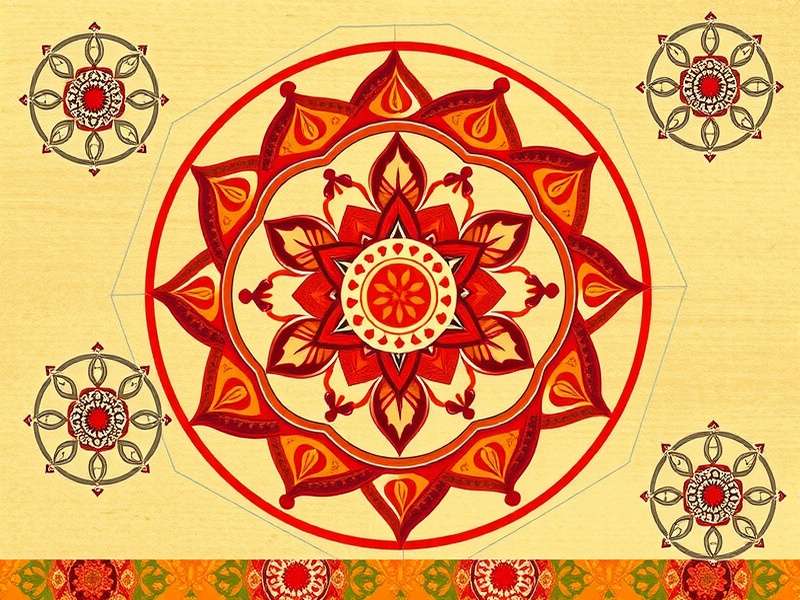Introduction to Timeless Mandala Puzzle
TheTimeless Mandala Puzzlerepresents one of India's most profound contributions to the world of contemplative games. This ancient puzzle combines mathematical precision with spiritual symbolism, creating an experience that engages both the logical mind and the intuitive heart.
What Makes It Special?
Unlike Western puzzles that focus primarily on problem-solving, theTimeless Mandala Puzzleincorporates elements of meditation, symmetry, and cosmic symbolism. Each piece and pattern carries deeper meaning beyond its physical form.
The game's design reflects the Hindu and Buddhist concept of the mandala - a geometric configuration of symbols that represents the universe. When players engage with theTimeless Mandala Puzzle, they're not just solving a puzzle; they're participating in an ancient tradition of cosmic contemplation.

Historical Origins and Evolution
The origins of theTimeless Mandala Puzzlecan be traced back to ancient Vedic traditions, where geometric patterns were used as tools for meditation and spiritual awakening. Early versions were carved in stone and wood, used by sages and scholars.
Ancient Roots in Indian Culture
Historical evidence suggests that similar puzzle forms existed during the Indus Valley Civilization (3300–1300 BCE). Archaeological findings reveal carved stones with geometric patterns that resemble modern mandala puzzles.
The golden age of theTimeless Mandala Puzzleoccurred during the Gupta Empire (4th to 6th centuries CE), when mathematics, astronomy, and spiritual practices flourished. Puzzles from this period show remarkable sophistication in their geometric complexity.
Temple Connections
Many ancient Indian temples feature mandala patterns in their architecture, and priests often used physical puzzle versions for teaching spiritual concepts to disciples. TheTimeless Mandala Puzzleserved as both educational tool and meditation aid.
Medieval Developments
During medieval times, the puzzle evolved with Islamic geometric influences, creating new hybrid forms. The Mughal era saw the creation of exquisite versions using precious stones and metals, often gifted among royalty.
The British colonial period nearly led to the disappearance of theTimeless Mandala Puzzle, as traditional practices were suppressed. However, rural communities and certain monastic traditions preserved the knowledge through oral traditions and handmade puzzles.
Rules and Gameplay Mechanics
TheTimeless Mandala Puzzlefollows a unique set of principles that distinguish it from conventional puzzles. The objective extends beyond mere completion to achieving a state of mental harmony.
Basic Components
A traditionalTimeless Mandala Puzzleconsists of several key elements:
Central Piece (Bindu)
The starting point representing cosmic consciousness, from which all patterns emerge.
Concentric Layers
Multiple rings of pieces that must be arranged in specific sequences.
Color Symbolism
Each color corresponds to different elements, chakras, or cosmic principles.
Geometric Patterns
Specific shapes like triangles, squares, and lotus patterns with spiritual significance.
Gameplay Process
Solving theTimeless Mandala Puzzleinvolves a meditative approach:
- Centering:Begin by focusing on the central piece while taking deep breaths
- Progressive Assembly:Work outward from the center, maintaining symmetry
- Pattern Recognition:Identify recurring geometric relationships
- Intuitive Placement:Allow intuition to guide piece selection
- Completion Ritual:Traditional practices upon finishing the puzzle
Time and Mindfulness
Traditional practitioners emphasize that theTimeless Mandala Puzzleshould not be rushed. The process matters more than speed, with some complex versions taking days or weeks to complete properly.

Cognitive and Spiritual Benefits
Engaging with theTimeless Mandala Puzzleoffers numerous benefits that modern science is only beginning to understand. These advantages span cognitive, emotional, and spiritual dimensions.
Psychological Advantages
Research into similar meditative practices suggests that regular engagement with mandala-based activities can:
- Reduce stress and anxiety levels significantly
- Improve focus and concentration span
- Enhance pattern recognition abilities
- Develop both logical and intuitive thinking
- Promote mindfulness and present-moment awareness
Therapeutic Applications
Modern therapists have adapted principles from theTimeless Mandala Puzzlefor treating PTSD, anxiety disorders, and attention deficits. The combination of tactile engagement and symbolic meaning creates a powerful therapeutic tool.
Educational Value
In educational settings, the puzzle serves multiple purposes:
Mathematical Learning
Teaches geometry, symmetry, and spatial reasoning through hands-on experience.
Cultural Education
Introduces students to Indian philosophical concepts and artistic traditions.
Visual Training
Develops keen observation skills and attention to subtle visual details.
Spiritual Dimensions
Beyond cognitive benefits, theTimeless Mandala Puzzleoffers profound spiritual value:
Traditional practitioners describe the puzzle as a "map of consciousness" that guides users through different states of awareness. The process of solving mirrors spiritual journeys - beginning from a central point of awareness and expanding outward to encompass broader understanding.
Many users report experiencing meditative states while working with the puzzle, describing feelings of timelessness, unity, and inner peace. These experiences align with descriptions of meditation in ancient Indian texts.
Modern Adaptations and Global Reach
In recent decades, theTimeless Mandala Puzzlehas experienced a renaissance, with new adaptations making this ancient practice accessible to global audiences.
Digital Transformations
Mobile applications and computer games based on theTimeless Mandala Puzzlehave introduced millions to this traditional practice. These digital versions maintain the core principles while adding features like:
- Progressive difficulty levels for skill development
- Guided meditation integrated with puzzle-solving
- Multiplayer options for shared spiritual practice
- Customization of colors and patterns
- Tracking of meditation time and puzzle statistics
Global Community
Online platforms have created international communities ofTimeless Mandala Puzzleenthusiasts who share techniques, custom designs, and personal experiences. This global network continues to evolve the practice while honoring its roots.
Contemporary Artistic Interpretations
Modern artists have embraced theTimeless Mandala Puzzleas both inspiration and medium:
Installation artists create large-scale interactive versions in galleries and public spaces. Fashion designers incorporate mandala puzzle patterns into textiles and accessories. Architects reference the geometric principles in sustainable building designs.

Scientific Research and Validation
Recent studies in neuroscience and psychology have begun to validate what traditional practitioners have known for centuries:
Brain imaging research shows that solving complex geometric puzzles like theTimeless Mandala Puzzleactivates both hemispheres of the brain simultaneously, creating unique neural synchronization patterns. This bilateral engagement may explain the reported states of heightened awareness and creativity.
Clinical trials exploring the therapeutic benefits have shown promising results for conditions ranging from age-related cognitive decline to trauma recovery. The combination of focused attention, symbolic engagement, and tactile manipulation appears to create optimal conditions for neural plasticity.
Academic Interest
Universities in India and abroad have established research programs dedicated to studying theTimeless Mandala Puzzleand similar traditional knowledge systems. These interdisciplinary efforts bridge humanities, neuroscience, and mathematics.
Cultural Significance and Preservation
TheTimeless Mandala Puzzlerepresents more than just entertainment; it embodies centuries of Indian philosophical thought, mathematical discovery, and spiritual practice.
Living Tradition
Despite modernization, traditional forms of the puzzle continue to be practiced in ashrams, temples, and households across India. Master puzzle makers still create handmade versions using techniques passed down through generations.
Annual festivals in regions like Rajasthan, Tamil Nadu, and West Bengal feature competitions and demonstrations of theTimeless Mandala Puzzle, ensuring that younger generations learn and appreciate this cultural heritage.
Global Cultural Exchange
As the puzzle gains international popularity, it serves as a bridge between cultures. Western practitioners often discover broader aspects of Indian philosophy through their interest in theTimeless Mandala Puzzle, leading to deeper appreciation of yoga, meditation, and Ayurveda.
This cultural exchange works in both directions, with international interest inspiring renewed appreciation within India for traditional practices that were once taken for granted or overlooked.
Preservation Efforts
Organizations like the Traditional Games Society of India and UNESCO have initiated programs to document, preserve, and promote theTimeless Mandala Puzzleas intangible cultural heritage. These efforts ensure that this wisdom tradition continues to enrich future generations.
Future Evolution
The ongoing digital transformation presents both challenges and opportunities for theTimeless Mandala Puzzle. While some purists worry about losing the tactile and meditative qualities of physical puzzles, innovators are finding ways to preserve the essence while expanding accessibility.
Emerging technologies like virtual reality and augmented reality offer exciting possibilities for immersive mandala puzzle experiences that could potentially enhance rather than diminish the spiritual dimensions of the practice.
As research continues to validate the cognitive and therapeutic benefits, integration of theTimeless Mandala Puzzleinto educational and healthcare settings seems likely to increase, ensuring this ancient practice remains relevant in the modern world.